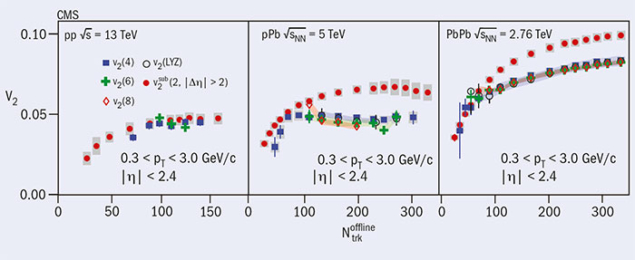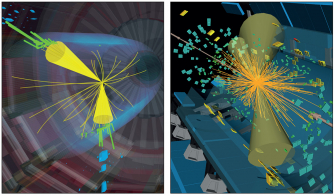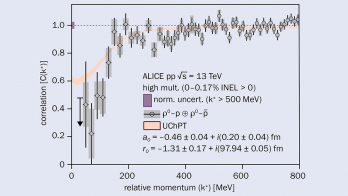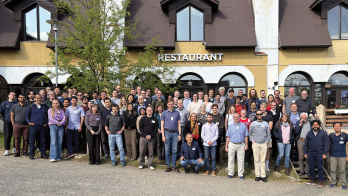
When heavy nuclei collide at high energies, a novel state of hot and dense matter – the quark–gluon plasma (QGP) – is expected to form. As a region of QGP expands and cools, it dissociates into a very large number of particles. Earlier findings at Brookhaven’s RHIC and CERN’s LHC revealed that the QGP exhibits strong collective behaviour comparable to a fluid. One of the key experimental pieces of evidence for this state is the observation of long-range anisotropic azimuthal correlations between particles emitted over a wide rapidity range, often referred to as the “ridge phenomenon”. In a typical proton–proton (pp) collision, a ridge correlation is not expected because the system is too dilute to produce a fluid-like state.

In 2010, however, CMS reported an unexpected observation of a ridge phenomenon in pp events with high particle multiplicities. This finding was regarded as a hint for possible collective effects that might occur in rare pp interactions with similar high particle densities as those in heavy-ion collisions. Due to statistical limitations of the LHC Run 1 data set, detailed studies of the ridge phenomenon in pp collisions, especially concerning its connection to collectivity, remained inconclusive. With the increased collision energy of the LHC Run 2, high-multiplicity pp events are produced at significantly higher rates. This makes it possible to perform a detailed examination of ridge and collective phenomena in pp collisions.
The CMS silicon tracking system is ideally suited for measurements of multi-particle correlations and therefore for studies of the collective nature of the ridge. Recently, the CMS collaboration measured the “elliptic-flow” harmonic v2 in pp events from LHC Run 2 as a function of particle multiplicity (see figure above). This is the first extraction of v2 – an observable that can be used to quantify the ridge signal – in pp collisions using a multi-particle correlation technique.
Strikingly, the observed v2 signals show nearly no dependence on the number of correlated particles, providing direct evidence for a collective origin for the long-range ridge observations. Similar observations were previously made in proton–lead and lead–lead collisions (see figure, middle and right, respectively), providing a consistent picture for the collective nature of the medium in all three collision systems. Furthermore, CMS studied long-range correlations using identified K0s and Λ hadrons, observing a clear dependence of the v2 signal on the particle species in high-multiplicity events. Such “mass ordering” provides further evidence for collective behaviour.
These intriguing observations, revealed through the study of small hadronic systems, therefore open up unexpected territory in the understanding and characterisation of dense quark–gluon matter. With the larger data samples of pp and pPb collisions to be collected in the future, CMS is poised for additional exciting physics discoveries in the coming years.








